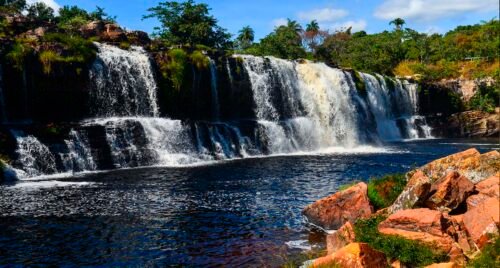Above all, speleology is the science that studies caves, caverns, and other underground environments, being essential for the analysis of risks and opportunities in Environmental Permitting.
Understanding the complexities of these karst landscapes, which may include underground rivers, rare speleothems, and specific fauna, is vital to ensure an environmental permissing. Here, various important aspects of speleology and its impact on environmental permitting will be explored. It is important to remember that although terms of reference consider speleological studies mandatory only in areas of high and very high potential for cave occurrences, the law does not permit impacts on caves occurring in areas of medium, low, or unlikely occurrence. Therefore, for the safety of any enterprise, it is important to analyze areas of interest for on-foot prospecting, in search of cavities that may lead to future fatal design errors if neglected.
What is Considered a Cave?
Legally, caves are broadly defined. According to Federal Decrees No. 6,640, dated nov/2008 and 10.935 dated jan/2022, a cave is any underground space accessible to humans, with or without an identified opening.
Formation of Caves and Their Connection to Surface Environments
Caves are primarily formed by water action, either through chemical dissolution or mechanical transport of material. Despite appearing isolated, they are closely linked to the surface environment. Thus, the good conservation status of the surroundings is crucial for the sustainability of these formations.
Energy Distribution in a Cave Ecosystem
Caves are dark environments, with low presence of organisms capable of producing their own energy. Energy within caves is primarily imported from the surroundings, through roots, animals using caves as shelter, and through water transport, gravity, or wind. Each point within the cave presents a different resource availability, impacting species distribution.
Importance of Caves
Cave environments have a range of importance, from biotechnological potential to roles in water purification and habitat for pollinating species. However, many caves are in areas of economic interest, making speleology a frequent issue in environmental permitting.
Need for Speleological Studies in Your Project
Brazilian speleological legislation is complex and exemplary, allowing impacts on caves through environmental feasibility and authorization from the responsible agency. The National Map of Cave Occurrence Potential guides the mandatory studies in projects, varying according to the area and the sphere of permitting.
Stages of Speleological Study:
- Initial Multicriteria Analysis: Uses drone images and georeferenced information for a more detailed refinement of speleological potential.
- On-Foot Prospecting: Searches for openings that could potentially be caves.
- Topographic Map Preparation: Drawing of cave contours and prominent components. Crucial for strategic planning.
- Environmental Feasibility Analysis: Considers the relationship between speleological heritage and its initial protection radius with planned project structures and activities.
- Delimitation of Speleological Influence Area: Establishes the area surrounding each cave necessary for maintaining physical and biotic characteristics.
- Relevance Studies: Classifies caves into maximum, high, medium, or low relevance considering multidisciplinary attributes specified in current legislation.
- Strategic Planning: Development of a robust speleological management program.
- Similarity Analysis: Evaluates possible similar caves based on relevance attributes and other pertinent characteristics, which may be incorporated into a compensation plan in cases where irreversible impacts on high or medium relevance caves cannot be avoided.
- Speleological Compensation Proposal: Presents a speleological compensation proposal, considering similar cavities that may suffer irreversible impacts and/or other forms of compensation.
- Speleological Management Program: Presents the necessary follow-ups and complementary studies to ensure the integrity of the speleological heritage throughout all project stages. Involves monitoring and speleological rescue.
Strategic Speleology
By adding speleological studies to the planning phase of your projects, various optimizations are ensured. This includes real efficiency in the conservation of Speleological Heritage, simplification of complex studies, and monitoring networks.
Types of Monitoring
- Influence Area: Evaluates the integrity of the cavity surroundings.
- Erosion Processes: Monitors points of erosion potentially impacting cavities and adjacent underground systems.
- Hydrological: Observes water availability and movement within and around the cave.
- Particulate Material: Assesses particle deposition inside the cave.
- Seismic: Records seismic activities to establish and monitor limits ensuring structural maintenance.
- Noise: Aims to ensure environmental quality of the cave and its surroundings, aiming to maintain bat colonies and other species.
- Photographic: Allows visual monitoring of changes over time, including structural changes and natural environmental dynamics, such as those caused by seasonality.
- Fauna: Studies frequency, disposition, and abundance of species over time.
- Organic Resources: Qualifies and quantifies trophic and biological resources within the cave.
- Microclimatic: Uses data loggers to record temperature and humidity, monitoring environmental stability of these environments.
Additional Methodologies
Each cave is a unique environment, some with particularities that go beyond traditional studies and may require customized solutions, such as installing level-loggers and other devices associated with specific themes.
In this sense, speleological management programs must always be customized, listing necessary technologies, layout of monitoring grids for each theme, as well as complementary studies that make sense for maintaining the integrity of underground ecosystems in the face of sustainable development.
However, the management of this valuable heritage must be carried out by experienced professionals to ensure the elimination of future risks and the optimization of speleological heritage conservation.
Count on Clam for the assertive viability of your project; we conduct studies on all relevant speleological themes, ensuring a safe, responsible, and sustainable environmental licensing for your project. Our multidisciplinary team is ready to offer the customized and efficient solutions you need. Get in touch to learn more about how we can help your business.






